It used to be that we described Walt Disney World's Epcot as a "permanent world's fair," but I find that I now often describe Expos as "temporary Epcots," with their international and corporate pavilions. Expos long have provided a type of sandbox for theme park designers; several popular Disney attractions - It's a Small World, Carousel of Progress and Great Moments with Mr. Lincoln - first saw light as exhibits at the 1964 Expo in New York.
The USA Pavilion at the Shanghai Expo 2010 takes visitors on a virtual trip to the United States through four show spaces. A pre-show welcome overture leads visitors into a three-screen film presentation on "The Spirit of America." From there, visitors enter the third show space, "The Garden," where they'll watch an "urban fairy tale" about a girl transforming an empty lot into a garden. This 4-D show show with in-theater special effects is projected onto five 30-foot-tall tower screens that visually transform into a variety of buildings and settings. The final space offers four themed areas where visitors can explore corporate displays on cooperation, sustainable development, health and nutrition, and high technology.
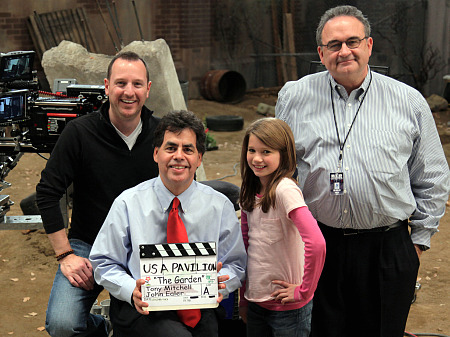
Theme Park Insider: What are some of the differences between designing for a World Expo and for a theme park?
Bob Rogers: The first big difference between a theme park and an expo is like the difference between a textbook and a blog. One must last; the other is completely now. A theme park attraction or major museum must stand 10, 15 or 20 years without requiring much of an update. Examples: BRC's Mystery Lodge at Knott's Berry Farm has been deeply resonating with guests for 16 years now. You achieve this by focusing on deep human issues that never get old. On the other hand a world expo pavilion plays for only six months. As a result you can be much more in the moment and immediately contemporary in thought and style.
Another big difference is that theme park attractions must be big fun and often do not have to be more. On the other hand, a pavilion at an expo must be big fun, but it must also have a touch of inspiration, education and humanity that leaves their guests intellectually and emotionally enriched while still delivering big fun. A great theme part attraction often does both. BRC Imagination Arts always tries to do both, regardless of the venue.
Theme Park Insider: What were some of the design challenges and opportunities involved with this particular Expo, versus others in the past?
Bob Rogers: BRC Imagination Arts has now conceived, designed, created and produced 11 pavilion shows and consulted on a dozen or so more all over the world. That experience has taught us that every expo is different but there are recurring aspects. Like every expo, Expo 2010 has had its own unique challenges. The USA Pavilion got off to an impossibly late start with a low budget. Lots of doomsayers claimed it could not be done in time. A year ago we proved to ourselves on paper that it could not be done in time. So, in an American tradition worthy of the USA Pavilion, we said "Damn the torpedoes; full speed ahead!" Impossible or not, we decided to get it open on time anyway. It has been an amazing come-from-behind story that plays out right up until a few moments before the ribbon cutting.
Another fascinating and unique thing unique about this expo is that this is China. What an exciting time to be in China! The cultural experience and the energy here have been amazing.
Theme Park Insider: How much are you finding that changes in technology over the years are affecting how you tell stories with your designs? Or are tech changes mostly affecting stuff in the background, and not the storytelling itself?
Bob Rogers: The principles of storytelling are timeless. The tools for delivering stories are ever-changing. Fresh delivery technology brings new energy to everything we do.
First example: At this expo programmable LED lighting and high definition projection are not new but they have fully arrived and are having tremendous impact all over the expo site. In the USA Pavilion we are mixing the two (programmable LED lighting and high definition projection) in an amazing new way. Our story, The Garden presents a heart-warming story about a girl (played by Rain Spencer) who has an innovative idea to replace a trash filled vacant lot with a community garden. By her optimistic determination, she wins the collaboration of her community. At the end of The Garden, a city that was once tired and gray becomes a magical vision of what can happen when optimism, innovation and collaboration come together.
The Garden unfolds around us on five "screen towers." These are five giant high definition screens, each over 10 meters (30 feet) tall, turned sideways (portrait style) so they stand upright, projected using state-of-the-art 2K digital high-definition. The screens are fancifully shaped like tall buildings. By projecting different images and graphic patterns on them, the screen towers become buildings, windows, bus stops, traditional movie screens or anything else one might imagine. Four-dimensional effects like real wind, rain and vibration in the theater add a sensory dimension, immersing the audience in an experience that is both emotional and visually stunning. Adding to the story, a contemporary music score plays through a multi-channel, 360-degree surround audio dynamic array. Additional low-frequency effects create rumbling and audio-layering, enhancing the impact of the story.
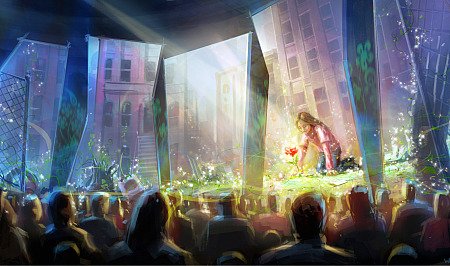
Here's where the LED's come in: An "out-glow" of LED lighting trims each of the screens, allowing us to change the color of the out-glow and turn it on/off or fade it scene by scene, shot by shot and cut by cut. Using about 100 programmed lighting cues PER MINUTE, the experience becomes a high-tech programmed light show worthy of a rock concert.
And in a timeless touch, this story is told without a word of dialogue, through moving images, music and sound effects. No translation is required. The Garden speaks to everyone, no matter what language they speak.
Second example: BRC Imagination Arts is also creating and producing the Information and Communications Pavilion sponsored by China Mobile and China Telecom. Here BRC is again using some amazing new high definition screen configurations (in one place up to 33 high definition screens above, around and surrounding the audience) but also something new: There is an additional active hand-held touch screen (The ICT Mobile Device) in the hands of every guest in the audience. So, when 500 people are in the 33 screen theater, there are actually 533 active screens.
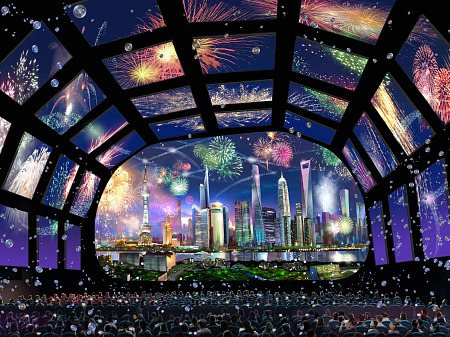
This BRC-designed ICT Mobile Device is all new, created only for this pavilion. (ICT stands for Information Communications Technology.) Every visitor to the Pavilion gets to borrow their own device which accompanies them throughout the various stages of the Pavilion exhibits and shows, allowing them to personalize their experience and to interact with what they see. In some areas guests personalize their experience by making selections using the touch screen. In other areas of the pavilion, as users see things that interest them, they swipe the device over the target and it collects that dream so they can learn more about it later at home. Or they take a picture. When the guest returns their device at the exit, their experience is downloaded and is transformed into a personal Web page for each guest which the guest can later access to retrieve their photos and to interact with other visitors who share their dreams. (In case you were wondering, no personal information is collected. Guests make-up a username and a numeric password to later access their individual page.)
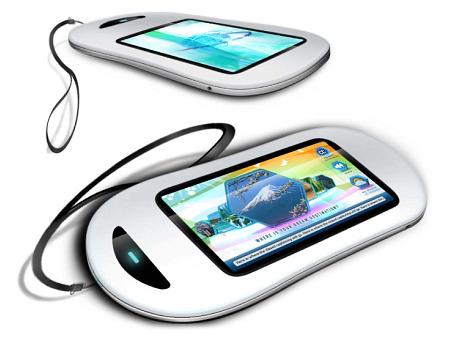
Bob Rogers: I look forward to the entire expo. A world's fair is an advance laboratory of creative and technical ideas for our industry. Expo pavilions try things. Some work, some fail but they all give you great ideas for your next project.
Theme Park Insider: Let's say a theme park fan is thinking about making the trip to China for this Expo. What are some of the other sights in the region that theme park fans also should be sure to see?
Bob Rogers: First, I would plan to spend at least a week seeing all of Expo. A world's fair is here today and then gone forever. After that, there are theme parks here. But China itself is at the dawn of a golden era. See China.
Update from Robert: Here's a new photo of The Garden theater, just released by the USA Pavilion:
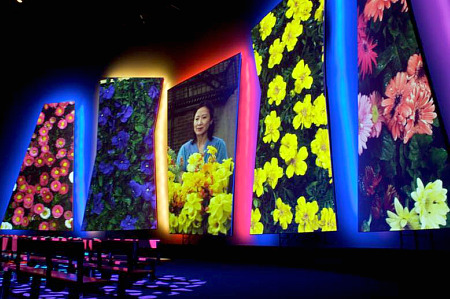
Bob also sent along this photo of Gate 8 at the Expo.
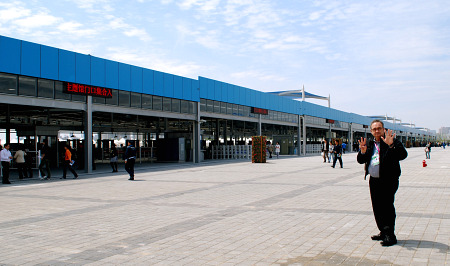
And I thought the Magic Kingdom entrance gates were big! And this is just one of the entry gates. How big will the Expo be? Bob wrote: "On the last Sunday before opening they had over 300,000 people on site – just a very 'light crowd' to help them test for Soft Opening. I am told that for Grand Opening (May 1) they plan to limit the crowd to between 500,000 and 600,000 guests, just to play it safe."
Tweet
Shanghai has a 4G wireless infrastructure. Why not put it to use? Wouldn't it be easier -- considering that (I read) 50,000 visitors will mob the US Pavilion each day for six months -- to have people use their own cellphones as interactive devices rather than give out and collect expensive handhelds that are sure to be damaged and lost?
Since we're into telling stories, what's the ultimate takeaway for the Chinese and world visitors? What will they remember most about the United States? I didn't get that. Thank you.
This article has been archived and is no longer accepting comments.